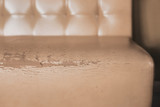RV Roof Types and Maintenance Tips
A leaky roof in your RV can cause stress during your travels and be expensive to repair. To reduce the likelihood of having to replace or repair your roof, it is important to clean and inspect your roof at least twice per year, but more is better! Don’t worry, it’s relatively easy to do when you stay consistent! Keeping the roof clean and checking for leaks or cracks routinely are relatively easy tasks that can have a big impact over time.
RVs come in all shapes and sizes, so roof maintenance is going to look a little different depending on the type of roof you have, the age of the roof, and the conditions that your roof sees. Some roof types are easier to repair, while other types will require the replacement of larger pieces. Before jumping into the cleaning and inspecting process, it is essential to know what kind of roof you have and some general characteristics of that type of roof.
RV Roof Types
PVC Rubber Roofing
PVC stands for polyvinyl chloride and is a single-ply material used for roofing due to its strength and durability. PVC has a breaking strength of at least 350 pounds per square inch and is resistant to chemicals and fire. A PVC rubber roof does a good job of reflecting heat which will help to keep your RV cool and save on energy costs. Speaking of eco-friendly perks, PVC rubber roofs can be recycled, even after years of use. There are various installation methods for PVC rubber roofing, including heat welding, solvent welding, and adhesive application. Adhesive application is probably the most accessible option for do-it-yourselfers, with PVC rubber roof kits available containing the necessary materials for success.
Rubber EPDM Roofing
EPDM stands for ethylene propylene diene monomer, a type of synthetic rubber material that is exceptionally resistant to weather conditions thanks to its unique molecular structure. Rubber EPDM is UV and ozone resistant, meaning you won’t see the same rapid aging that is present in other types of rubber with sun exposure. Surface scratches and scuffs are less likely to occur with EPDM roofing, but, if necessary, repairs are quick and easy thanks to the metal adhering properties. One disadvantage to consider with this type of roofing is that it absorbs heat more quickly than other types of roofing, even with lighter colored materials. Also, EPDM is susceptible to damage from solvents, hydrocarbons, and particular lubricants which it may come in contact with.
Rubber TPO Roofing
TPO stands for thermoplastic polyolefin and is another type of rubber commonly used for RV roofs. TPO roofs consist of a single-ply synthetic layer with reinforcing scrim around the seams, which must be installed via heat welding. Scrim is a heavy, coarse woven material that is used as lining. TPO resists weather and chemical erosion and does not promote mold or mildew growth. The material costs associated with rubber TPO roofs are less than those associated with other synthetic rubber roofing options. However, the technology is relatively new, so long-term cost-effectiveness is still up for discussion.
Fiberglass Roofing
Fiberglass roofing is made from synthetic materials and glass fibers, making it both flexible and durable. Rot, rust, and fire-resistant properties provide piece-of-mind regarding long-term durability. Aesthetically speaking, fiberglass roofs can be easily customized to match a certain color or molded into simple and complex shapes depending on your needs. Roof maintenance is essential with this type of roof as repairs are generally more expensive and may involve replacing entire sections rather than an easy spot repair due to the structure of the material. Luckily, the durability of this material reduces the likelihood that detrimental damage will occur. Fiberglass roofing is installed onto a base, typically plywood, using adhesive, so no welding is required.
Aluminum Roofing
Aluminum roofing remains a desirable option for some RV owners due mainly to durability and appearance. Aluminum is one of the more expensive roofing options for initial material costs, but the durability and longevity of the material may make up for it in the long run. When properly installed and maintained, aluminum is resistant to punctures, sunlight, and rust damage. While aluminum is considered lightweight amongst metal standards, it is deemed heavy by RV building material standards. Certain RV manufacturers are known for their aluminum roofing, but this type of roofing is less commonly being installed on the majority of newer models.
Regular Maintenance Tips
Safety First
Not all RV roofs are strong enough to support your weight; typically, those without attached ladders are not designed to be walked on. If you will be cleaning and checking your RVs roof from on top of it, be careful because the roof may be slippery, sloped, or have obstacles to be aware of on top. If you are unable to get atop of your RV, you can still access most, if not all, of the roof from a ladder set against the sides.
Rubber Roofs
Though there are various rubber roofing options, most share similar maintenance guidelines. For rubber roofing, avoid cleaners and conditioners that contain harsh abrasives, petroleum solvents, and citrus ingredients. For light cleaning, a mild detergent and a medium bristle brush should sufficiently remove dirt and debris without damaging the surface of your roof. Light cleaning of rubber roofs should occur 3-4 times per year, depending on weather and storage conditions. If your RV spends lots of time under sappy trees where lots of birds hang out, this may need to be done more often. Specialty products for rubber care and conditioning can prevent brittleness and cracking of your roof when applied regularly. Heng’s Industries Roof Coat Rubber Coating is a great product to add to your rubber roof care regime A good rule of thumb is to condition your rubber roof after every five washes, or once per year.
Whenever you are cleaning your roof, it is a good idea to check all the roof seams and sealants around openings to make sure they are intact, and there are no gaps or leaks. Water will pass through even the tiniest seam opening and can cause a disproportionate amount of damage, so catching any damage early is key to avoiding costly repairs. Specialty patches, tapes, and resealing kits are available for minor repairs to your rubber roof. Be sure to follow manufacturer instructions on the proper application of such products.
Fiberglass Roofs
Fiberglass is a durable material that can last a long time but will still require regular cleaning in order to keep up a neat appearance. A gentle detergent is recommended for light cleaning of fiberglass roofs because harsh abrasives or chemicals may strip away the material’s durable properties and lead to damage later down the road. Applying a wax treatment once a year can provide increased protection from UV damage and remove light oxidation, which may be present. If you are going to be applying a wax treatment especially, but even for regular cleaning, avoid working in direct sun during the middle hours of the day as this may lead to unsightly water spots.
Aluminum Roofs
Aluminum roofs probably require the least amount of maintenance for the RV roofing types discussed here. Aluminum roofs are naturally resistant to rust and sun damage, so conditioning and waxing are unnecessary. Keeping your roof clean from dust and debris is still recommended and will keep your rig looking shiny and nice. Regular inspection of seams and seals is the best way to curb expensive repairs or large replacements. Small repairs can be made using particular peel and stick patches. It is possible that you may need to reseal your aluminum RV roofing if there was a repair you did or if seams and seals are looking weak. Specialty products are available for this.
What type of roof do you have on your RV? What is your current cleaning routine?
Recent Posts
-
How to Keep Your Pets Safe While Camping
RVing and camping are a great getaway from the hustle and bustle of work and the city and the day-to …Jul 2nd 2024 -
Why Replace Your RV Furniture?
You may wonder when is the best time to replace your RV furniture. There is no one right answer to t …May 20th 2024 -
Can You Put Regular Furniture in an RV?
Many new and old RV owners ask themselves this question when they feel the need to update th …Apr 25th 2024 -
4 Tips for Securing RV Furniture While Traveling | RecPro
How To Secure RV Furniture There are few things that beat going out on an adventure with an RV …Apr 25th 2024 -
How To Keep RV Furniture From Peeling
Peeling RV Furniture | Why it Peels and How to Stop it Your RV furniture is a point of pride on yo …Apr 25th 2024 -
Turning up the Heat With an RV Fireplace
There’s an unlimited number of cool and exciting features you could add to your recreational vehicle …Apr 25th 2024







